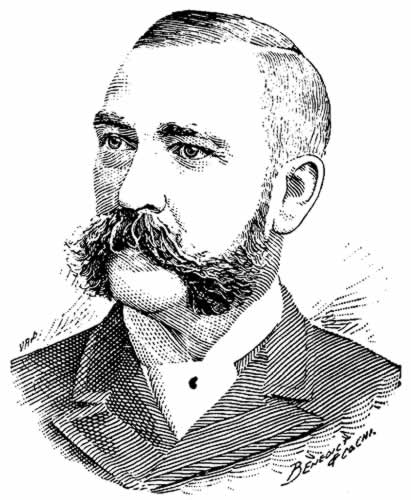
Ohio Columbus
Barber
America's Match King
(1841-1920)
Ohio Columbus Barber was the second son of George and Eliza Barber. George Barber was a versatile Yankee peddler/cooper/hotel keeper who immigrated to the Connecticut Western Reserve in 1826. He prospered, married, and settled in Middlebury, a thriving village later annexed to Akron.
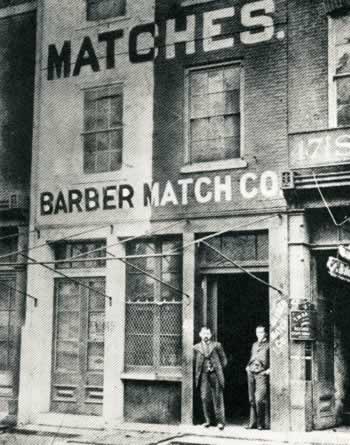
George Barber (left) and His son, Ohio C. Barber,
stand outside of the Barber Match Plant on Fowler Street
in Akron in 1871.
A curious tinkerer with a scientific bent, George Barber acquired tools and equipment for the hand manufacture of matches in 1845. As the venture prospered, his young sons would sell the product door to door in hand baskets. The Barber family and their helpers boosted productivity. Soon the factory relocated to a former blacksmith shop and continued to expand first using water power from the little Cuyahoga and later, after moving to Akron, steam power with water taken from the Ohio Canal.
The productivity expanded beyond the needs of the local market. At age 16 Ohio Columbus Barber became the company salesman, meeting the canal boats and distributing the matches to country stores by horse and wagon. Business was conducted largely by barter. He became factory manager at age 20.
The Civil War brought hardship to the company due to an increased tax burden. The family lost its soldier son, George H. Barber, to dysentery. Incorporation of the Barber Match Company provided the needed capital for survival. By 1880 the Barber firm was number one in Ohio and gained 20% of the national market.
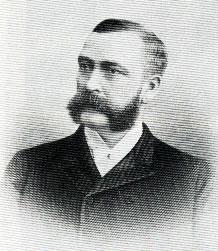

Ohio
Barber in his thirties Laura
Brown Barber, first wife of O.C. Barber
At age 26 Barber married Laura Brown of Coventry. They had 2 children, Anna and Charles, but Charles died in infancy.
Pictures from Harper's Weekly
June 22, 1878.
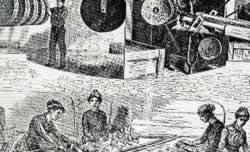

Match making in the 1870's
In the 1870's improved machinery and access to railroads allowed the Barber Company to become one of the largest of the U.S. match producing companies.
Unregulated competition made it difficult to keep the company stable and solvent. Other match companies had the same difficulties. In 1881 twelve companies agreed to consolidate into one, the Diamond Match Company. Diamond was a Barber brand suggested by the shape of its splint.
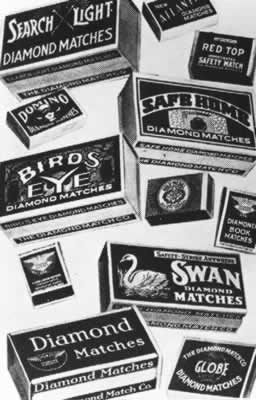
Various Diamond Match Company Products
Diamond Match took over 85% of the national market in the i880's. Its headquarters now in Chicago, Diamond attracted wealthy investors in the city. Barber began to travel abroad with a view to setting up a global market.
Barber never lost interest in Akron or Ohio. He took a personal interest in modernizing Akron's utilities and improving Diamond's factories and its employees' welfare.
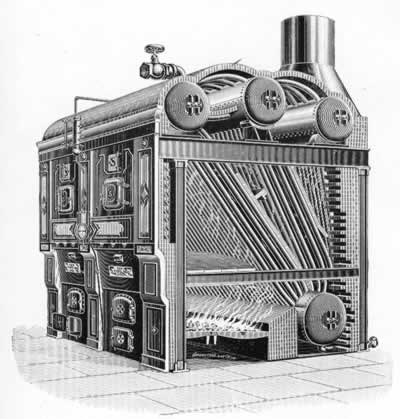
In the 1890's a period of amazing diversification began. A factory making strawboard led to a national consolidation of strawboard manufactures with Barber as president. Aware of the consequences of fire caused by volatile chemicals, Barber formed a company to make fire extinguishers and steel tubing. Through mergers the fire extinguisher company became part of the Grinnell Corporation. When boilers became necessary power sources in the Barber companies, he went into the boiler business with the inventor Allen Stirling, making a new type of boiler. The Stirling Boiler Company became by merger the Babcock and Wilcox Company. Other new enterprises produced sewer pipe, ammunition, aluminum, pottery, tiles, woolen, and felt.
By the turn of the century activities leading to consolidations were referred to as trusts. Popular opinion was against the great monopolies that got everything their way. Barber would defend his own interests by letters to the editors of the local newspapers. A bitter confrontation with the Summit County Tax assessor over the size of Barber holdings led to a lot of bad press for Barber and detracted permanently from his public image. He changed his official residence to a hotel in Chicago.

W. A. Johnston's original map of Barberton
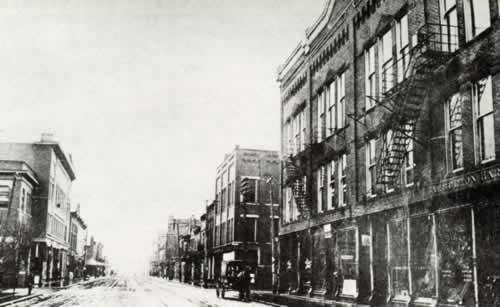
Business district of Barberton in the 1890's
For the Barber vision of expansion to take place unimpeded a new location would be required. He began to acquire land in New Portage, a village near Akron. The land would be the site of a planned industrial city to be called Barberton. The Barberton Land and Improvement Company was organized to develop the project. Factory and home construction followed quickly. The term "Magic City" was coined by awed observers and became its permanent popular designation.
The new town and its busy factories were served by railroads and the Ohio Canal. Barber organized the Akron-Barberton Beltline Railroad to enhance access to those railways serving Akron.
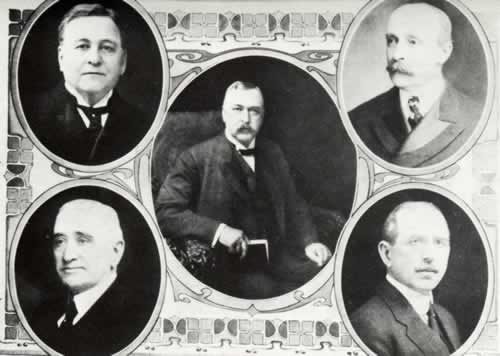
DIAMOND OFFICERS IN 1908
J.K. Robinson, Treas. Chas.
H. Palmer, VP
O.C. Barber, Pres.
Jas. Hopkins, VP H.C.
Cranz. Aud.

Barberton plant of the Diamond Match Company
The city of Barberton was incorporated in 1891. A severe business downturn threatened to destroy the economic base of the city. Barber had another magic trick left: he built in Barberton a modern new match factory for Diamond Match to replace its Akron plant. This assured the future of the city he had conceived.

Liverpool plant as it appeared in
Twenty-seven Years, 1881-1908, The Diamond Match Company.
The plant was destroyed by German bombs in World War II
The big dream of a global match market with Diamond companies encircling the world would be filled with unpredictable obstacles. Unfriendly takeover attempts were focused on the company in the United States. Though unsuccessful, they weakened the resources needed for expansion. Speculators, inside and outside the company, were a constant harassment. Despite all the difficulties, Barber was ultimately successful in creating a framework of worldwide match factories.

Lumber as piled at Barber, California
In 1906 he decided that a large supply of lumber should be acquired to meet the needs of the global market. A huge forest in the Sacramento Valley of California was purchased and scientific forest management was introduced to conserve and replenish the timber land. Another large investment was required to build a railroad to transport the trees to sawmills and lumber yards. The villages of Barber and Stirling City grew up, one at each end of the railroad. Opposition to these costly programs was quick in coming and so bitter that Barber decided to retire in 1908. He handpicked his next two successors and was active in the company affairs until his death in 1920.
His 20th century business activities were still impressive. Rubber products and cereal mills were among Akron's rapidly growing industries, and Barber played an active role in each. Oatmeal company mergers were not among his successes. The Diamond Rubber Company was a great success and merged with B.F. Goodrich in 1911. The strawboard consolidation was unsuccessful and costly.
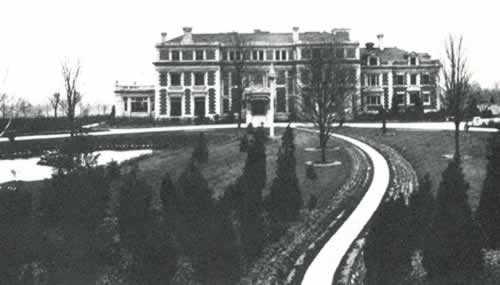
Eastern view of the Anna Dean Farm Mansion
In 1905 he began his last great project. By 1910 he owned 3,000 acres of farm land near Barberton. He set about creating a scientific farm and a kingly residence. Farm related businesses mined fertilizer at Barber, Virginia, milled flour and cereal, and produced decorative concrete work. His agricultural produce enjoyed wide distribution.

Akron City Hospital, 1904
Barber continued to take an interest in Akron long after he founded the city of Barberton. Akron philanthropic projects included construction of Akron City Hospital in 1904 and in 1906 Barber founded the Akron Chamber of Commerce.


Mary Orr Barber Ohio
C. Barber
After being a widower for twenty years, Barber remarried in 1915 to his secretary Mary Orr. She shared his vision and after his death five years later attempted to fulfill his plan for the farm, which was to be willed to Western Reserve University and used as an agricultural college. However ultimately this was not to be, and alone Mary was not able to operate such a huge concern dedicated to scientific farming.
For complete biographical material see: America's Match King, Ohio Columbus Barber, 1841-1920.